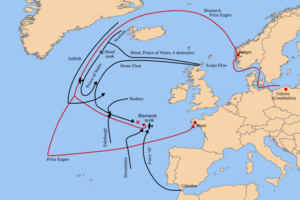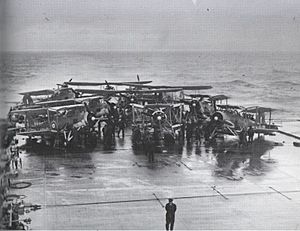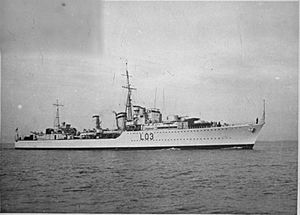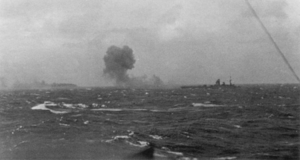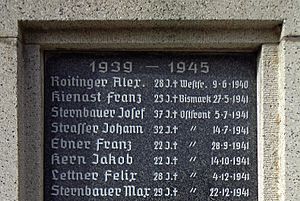Last battle of Bismarck facts for kids
Quick facts for kids Last battle of Bismarck |
|||||||
|---|---|---|---|---|---|---|---|
| Part of Operation Rheinübung | |||||||
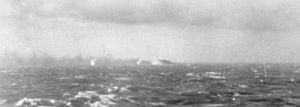 Surrounded by shell splashes, Bismarck burns on the horizon |
|||||||
|
|||||||
| Belligerents | |||||||
| Commanders and leaders | |||||||
| Strength | |||||||
| 1 aircraft carrier 2 battleships 1 battlecruiser 2 heavy cruisers 1 light cruiser 8 destroyers |
1 battleship | ||||||
| Casualties and losses | |||||||
| 49 killed 5 wounded 1 destroyer scuttled 1 battleship lightly damaged |
2,200 killed 110 captured 1 battleship scuttled |
||||||
The last battle of the German battleship Bismarck happened in the Atlantic Ocean. It took place on May 26–27, 1941. The battle was between the German battleship German battleship Bismarck and ships and planes from the British Royal Navy. This fight was the end of Operation Rheinübung. In this operation, two German ships tried to stop supply convoys going to the United Kingdom.
The final battle had four main parts. First, on May 26, British planes attacked Bismarck. They damaged her steering, making her unable to escape. Second, British and Polish destroyers followed Bismarck all night. They attacked her but caused no major damage. Third, on the morning of May 27, British battleships and cruisers attacked. After about 100 minutes of fighting, Bismarck sank. This was due to shell hits, torpedoes, and her crew sinking her on purpose. The British rescued 110 survivors. They had to leave quickly because they thought a German U-boat was nearby. Later, a German U-boat and a weather ship rescued five more people. In the final part, German planes attacked the British ships on May 28. This led to the loss of the destroyer HMS Mashona.
Contents
Background to the Battle
The German battleship Bismarck and the heavy cruiser Prinz Eugen were under the command of Admiral Günther Lütjens. They tried to get into the Atlantic Ocean to attack ships carrying supplies. British ships from the Home Fleet found them. On May 24, in the Battle of the Denmark Strait, Bismarck was damaged. Her fuel tanks were hit, and some parts of the ship filled with water. Her captain wanted to reach the port of Brest in France for repairs.
The British wanted to get revenge for the sinking of their ship, HMS Hood. So, they sent every possible ship to hunt down Bismarck. Many British ships joined the hunt. These included the battleship King George V, the battlecruiser Repulse, and the aircraft carrier HMS Victorious. Other ships like Rodney and Force H (with the aircraft carrier Ark Royal) also joined.
On May 24, Bismarck briefly turned to face her pursuers. This allowed her companion, the heavy cruiser Prinz Eugen, to escape. Later that evening, planes from Victorious attacked Bismarck. One torpedo hit, but it only caused minor damage.
Early on May 25, the British lost track of Bismarck. They thought she was going back to Norway. But Bismarck was actually heading towards France. Admiral Lütjens, the German commander, sent a radio message. This helped the British figure out Bismarck's true direction. Both sides were running low on fuel. Bismarck had to travel slower because of her battle damage and lack of refueling. Many British ships also had to leave the chase due to low fuel. Only King George V and Norfolk could continue. Five destroyers, including the Polish destroyer ORP Piorun, were ordered to join King George V.
On May 26, at 10:30 AM, a Catalina reconnaissance plane spotted Bismarck. It had flown from Northern Ireland. The plane saw an oil slick from Bismarck's damaged fuel tank. This allowed the British to know her exact location. Now, all British hopes were on Force H and the destroyers. They needed to slow Bismarck down before she reached safety.
The Battle Begins
First Phase: Ark Royal Stops Bismarck
On May 26, at 2:50 PM, the aircraft carrier Ark Royal launched 15 Swordfish planes. These planes were going to attack Bismarck. The pilots were not told that the British cruiser Sheffield was nearby. So, the Swordfish planes accidentally attacked Sheffield first. Luckily, some torpedoes didn't work, and Sheffield avoided the others.
The same planes were launched again at 7:10 PM with different torpedoes. At 7:50 PM, Force H came across a German submarine, U-556. The submarine was in a perfect position to attack Ark Royal and Renown. But it had already used all its torpedoes.
The planes finally found Sheffield at 8:00 PM. Sheffield guided them to Bismarck. The attack started at 8:47 PM. One torpedo hit Bismarck in the middle, but it didn't do much damage. A second torpedo hit the back of the ship. This jammed Bismarck's rudder and steering gear. This meant Bismarck could only steam in a large circle.
Bismarck fired her guns at the attacking planes. After the attack, Bismarck fired at Sheffield. Shell pieces rained down on Sheffield, killing three sailors and wounding two. Sheffield quickly hid behind a smoke screen. Sheffield lost sight of Bismarck in the bad weather. But she soon met the five destroyers and guided them to Bismarck. The battleships King George V and Rodney were also getting closer. The heavy cruiser Norfolk and the light cruiser Edinburgh were also approaching. Edinburgh had to leave due to low fuel. Norfolk stayed to the north of Bismarck. Another heavy cruiser, Dorsetshire, was coming from the west.
Bismarck's crew tried to fix the rudder, but they failed. Bismarck tried to steer by changing the power of her propellers. But the strong wind and rough sea forced the ship to sail towards King George V and Rodney. At 11:40 PM on May 26, Admiral Lütjens sent a message to Germany. He said, "Ship unmanoeuvrable. We will fight to the last shell. Long live the Führer."
Second Phase: Destroyers Harass Bismarck at Night
One hour after the Swordfish attack, the destroyers Maori and Piorun found Bismarck at 10:38 PM. Piorun attacked right away, showing she was a Polish ship. But she couldn't launch torpedoes. The weather got worse, making a big attack impossible. All night, Bismarck was attacked by torpedoes from the destroyers. Between 10:38 PM and 6:56 AM, the destroyers Cossack, Maori, Zulu, and Sikh fired sixteen torpedoes. None of them hit. One of Bismarck's shells hit Cossack's antenna. Three other shells landed very close to Zulu, wounding three sailors. The constant attacks by the destroyers tired out the German crew.
Between 5:00 AM and 6:00 AM, Lütjens ordered an Arado 196 float plane to be launched. He wanted to send the ship's war diary and other important papers to France. But they found that the plane catapult was broken from earlier battle damage. The plane was pushed overboard to prevent a fire. Lütjens then asked for a U-boat to pick up the documents. The U-556 was assigned, but it was underwater and missed the order. It also didn't have enough fuel. The task was then given to U-74, but by then Bismarck had already sunk.
Third Phase: Bismarck is Lost
As the British ships got closer to Bismarck, Admiral Tovey gave his orders for the final battle. He told the Renown not to join the fight. Renown had similar armor to the Hood, and Tovey didn't want to risk another loss. He told the commander of Rodney to get as close as possible. The morning of May 27, 1941, was cloudy with rough seas and strong winds. Tovey decided to attack Bismarck from a certain direction to make it easier.
Norfolk was the first ship to see Bismarck that morning. In bad visibility, the cruiser came across an unknown ship. It flashed recognition signals before realizing it was the German battleship. Norfolk quickly turned away and contacted the British battleships before joining the final battle. At 8:43 AM, lookouts on King George V spotted Bismarck. Rodney fired first at 8:47 AM, followed quickly by King George V. Bismarck could not steer because of the torpedo damage. The rough seas also made it hard for her to aim her guns.
However, Bismarck fired back at 8:50 AM. Her second volley of shells landed very close to Rodney. This was the closest Bismarck came to hitting a British warship in this final fight. At 9:02 AM, a 16-inch shell from Rodney hit Bismarck's front. This damaged the bridge and main fire control, killing most of the senior officers. The shell also damaged the front main gun turrets. The back fire control station took over, but it was also knocked out after three more volleys. With both fire control stations out of action, Bismarck's shooting became very wild. This allowed the British ships to get closer. Norfolk and Dorsetshire also moved in and started firing their 8-inch guns. Around 9:10 AM, Norfolk fired four torpedoes and Rodney fired six, but no hits were seen.
By about 9:31 AM, all of Bismarck's four main gun turrets were out of action. The ship could no longer fight back. First Officer Hans Oels, the highest-ranking officer still alive, ordered the crew to sink the ship. He told them to stop trying to control damage, open all watertight doors, and prepare charges to blow up the engine room. Oels moved through the ship, giving these orders. Around 10:00 AM, a shell from King George V hit the ship and exploded, killing Oels and about a hundred others. Gerhard Junack, the senior engineering officer, ordered his men to set demolition charges with a 9-minute fuse. He then ordered the engineering crew to leave the ship.
Once all of Bismarck's main gun turrets were destroyed, Rodney moved very close, about 2,700 meters away. She fired her guns at Bismarck's upper parts. King George V stayed further away. This was to make sure her shells would hit Bismarck's decks from above and go inside. At 10:05 AM, Rodney launched four torpedoes at Bismarck, claiming one hit.
By 10:20 AM, the British battleships were running low on fuel. Bismarck was sinking by the back and leaning to the left. So, Tovey ordered Dorsetshire to get close and torpedo the damaged Bismarck. King George V and Rodney then left and headed for port. By the time Dorsetshire fired her torpedoes, Bismarck was leaning so much that her deck was partly underwater. Dorsetshire fired two torpedoes at Bismarck's right side, and one hit. Dorsetshire then moved to the left side and fired another torpedo, which also hit. Bismarck started to capsize (turn over) at about 10:35 AM. By 10:40 AM, she had slipped beneath the waves, stern first. During the battle, the two British battleships fired about 700 large shells at Bismarck. In total, King George V, Rodney, Dorsetshire, and Norfolk fired about 2,800 shells, hitting Bismarck about 400 times.
Fourth Phase: German Air Attacks
The German air force, the Luftwaffe, could not help on May 26 because of bad weather. Only a few reconnaissance planes found Rodney. On May 27 and 28, some German planes tried to attack the British ships. On the morning of May 27, one Heinkel He 111 plane missed Ark Royal with bombs. Only four bombers found the British battleships, but they didn't hit anything.
On May 28, the destroyers Mashona and Tartar were heading for Northern Ireland. They were low on fuel. At 9:00 AM, Mashona was hit by a bomb. Forty-six crew members were lost, and the ship was abandoned. An attempt to sink her with a torpedo from Tartar failed. She was then sunk by gunfire from other destroyers. The destroyer Maori was also damaged by bombers.
Survivors
Dorsetshire picked up 85 survivors, and Maori picked up 25. At 11:40 AM, a lookout on Dorsetshire thought he saw a submarine periscope. The rescue effort stopped, leaving hundreds of Bismarck's crew in the water. A British sailor named Joe Brooks jumped into the water to help wounded Germans. One German sailor had lost both arms and was holding onto a rope with his teeth. Brooks tried to save him but couldn't. Brooks was almost left behind when the submarine alarm sounded. But his shipmates threw him a line and pulled him aboard.
After the battle, the British ships returned to the United Kingdom with 109 Bismarck survivors. One survivor died the next day and was buried at sea. That evening, a German submarine, U-74, picked up three survivors from a small boat. The next day, the German weather ship Sachsenwald picked up two more survivors from a raft. A Spanish cruiser also arrived but found no survivors. Out of a crew of over 2,200 men, only 114 survived.
Aftermath of the Sinking
After Bismarck sank, Admiral John Tovey said she fought bravely against impossible odds. He said she went down with her flags still flying.
The British Navy leaders sent a message of thanks. They congratulated everyone involved in finding and destroying the powerful German warship. They said the loss of HMS Hood had been avenged. They also said the Atlantic Ocean was now safer for trade. They thanked the Fleet Air Arm (naval aviation) for their bravery and skill.
The German command base did not know Bismarck had sunk for some hours. They kept sending messages to the ship. Then, Reuters reported news from Britain that the ship was gone. In Britain, the House of Commons was told about the sinking that afternoon.
Ships Involved
German Side
- German battleship Bismarck
Allied Side
In the Final Battle
- The battleships King George V and Rodney.
- The heavy cruisers Norfolk and Dorsetshire.
Made Contact Before Final Battle
- 15 Swordfish planes from the aircraft carrier Ark Royal
- The light cruiser Sheffield.
- The destroyers Cossack, Sikh, Zulu, Maori
- The Polish destroyer Piorun
Supporting Ships
- The aircraft carrier Ark Royal
- The battlecruiser Renown
- The destroyers Mashona, Tartar
See also
- Sink the Bismarck!, a 1960 film based on C. S. Forester's book The Last Nine Days of the Bismarck
- "Sink the Bismarck", a 1960 song by Johnny Horton inspired by the film of the same name.
- Computer Bismarck, a 1980 computer game that simulates the battle.
- Unsinkable Sam, a ship's cat on board Bismarck who allegedly survived the sinking and was adopted by the Royal Navy; probably a tall tale.


